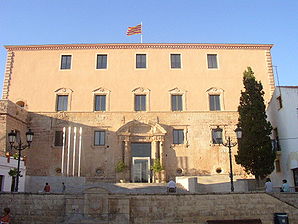Torredembarra
| Torredembarra municipality | ||
|---|---|---|
 Town hall in the castle of Torredembarra
|
||
| coat of arms | Map of Spain | |

|
|
|
| Basic data | ||
| Autonomous Community : | Catalonia | |
| Province : | Tarragona | |
| Comarca : | Tarragonès | |
| Coordinates | 41 ° 9 ′ N , 1 ° 24 ′ E | |
| Height : | 5 msnm | |
| Area : | 8.7 km² | |
| Residents : | 16,184 (Jan 1, 2019) | |
| Population density : | 1,860.23 inhabitants / km² | |
| Municipality number ( INE ): | 43153 | |
| administration | ||
| Official language : | Castilian , Catalan | |
| Mayor : | Daniel Masagué | |
| Website : | www.torredembarra.cat | |
Torredembarra is a city in the Catalan province of Tarragona in northeastern Spain . It is in the comarca of Tarragonès .
Geographical location
The municipality is located between Tarragona (13 km) and Barcelona (75 km) on the Costa Daurada and is accessed by the N-340 national road, the A-7 motorway and the Barcelona-Tarragona railway line.
history
Torredembarra or La Torre , as the city is often (unofficially) called, is of Roman origin. The importance of the settlement did not begin until 1057 when Raimund Berengar I , Count of Barcelona , donated it to a few knights who, in return, undertook to build a stone tower. The simple tower was first called Clará , later Torredembarra . The Romanesque parts of the church of Sant Joan de Clará still bear witness to this settlement period . After this old castle fell into disrepair over time, the local feudal lord Lluís d'Icart had a residential fortress built in the center of today's town in 1565.
The city expanded significantly in the 18th century due to the boom in trade and business of the wealthy returnees from America.
economy
The historic fishing town has developed into a tourist center since the 1960s. Today tourism is a major source of income for Torredembarra.
Culture and tradition
According to legend, the arrival of an image of Saint Rosalia in 1640 ended a plague epidemic. Therefore, not the actual name day of the patron saint on September 4th is the highest holiday in Torredembarra, but the anniversary of the arrival of the image and La Festa del Quadre de Santa Rosalia ("Feast of the Image of Saint Rosalia") is celebrated on July 15th .
Torredembarra has a tradition in Castells' competitions; In 1983 an Enxaneta belonging to the Nois de la Torre group fell fatally while one of these human pyramids was being built .
Worth seeing
The parish church of Sant Pere was built in 1680 and equipped with a baroque organ in 1705 . The image of Saint Rosalia, venerated in Torredembarra, also hangs there .
The oldest preserved building in the town is the Mudejar-style city tower from the 12th or 13th century. It must have been part of the old castle.
The Torredembarra Town Hall in the former residential fortress of Lluís d'Icart is the only secular Renaissance building that has survived in Catalonia.
In front of the 4 km long fine sandy beach there is a sculpture by Rafael Bartolozzi : “Alfa i Omega” on a concrete base on which the towing machinery for the fishing boats was previously attached .
This sculpture had to be removed in 2018 due to corrosion.
Town twinning
- Villars in the Loire department , ( France )
sons and daughters of the town
- Gerardo Gatell Valls (1940–1989), football player
- Berta Castells (* 1984), hammer thrower
Web links
Individual evidence
- ↑ Cifras oficiales de población resultantes de la revisión del Padrón municipal a 1 de enero . Population statistics from the Instituto Nacional de Estadística (population update).
- ↑ Enxaneta (i.e. squirrel ) is the name given to the person at the top of the pyramid.


